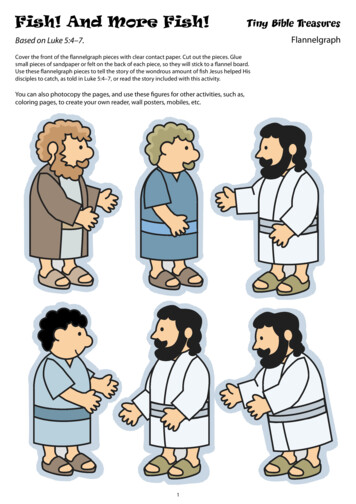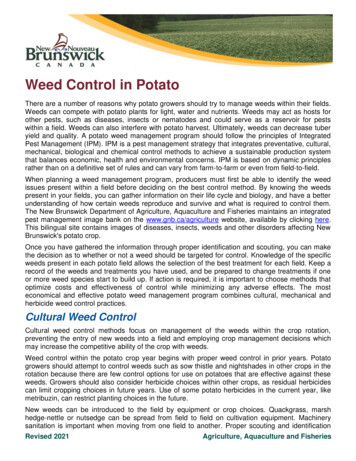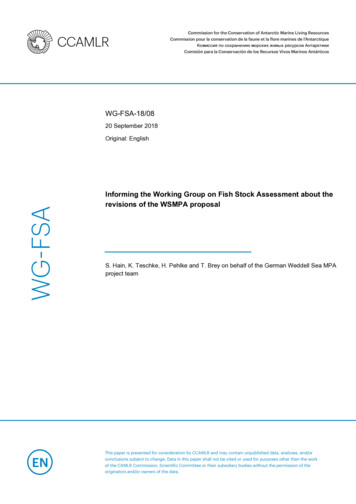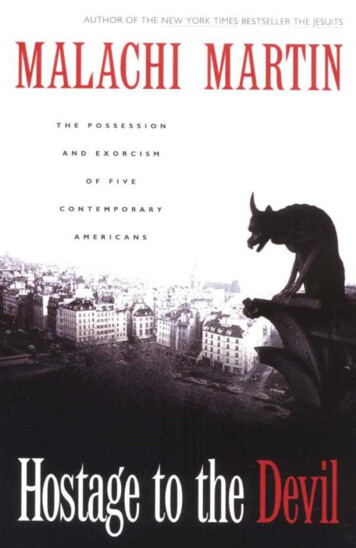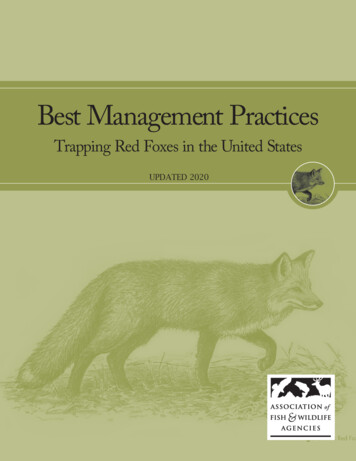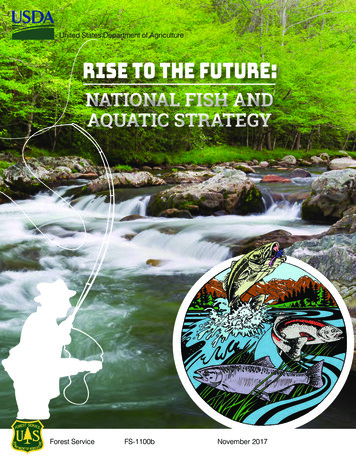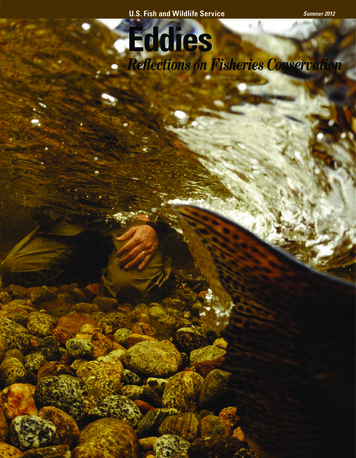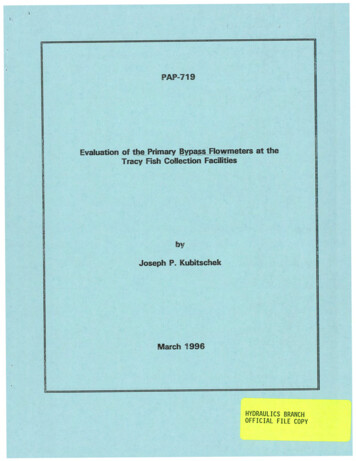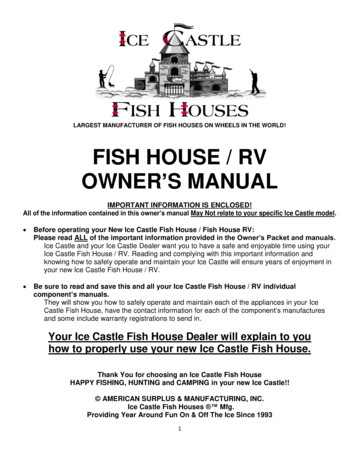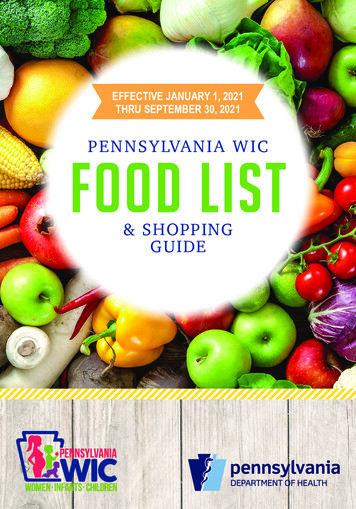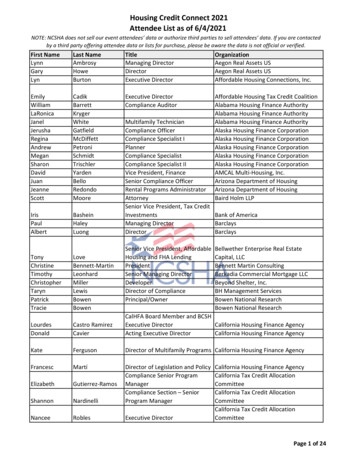
Transcription
Fish 2021A part of our heritage
Did you know? Your season Angling Licence is now valid from April 15th until March 31st of the following year. This means the upcomingwinter fishing season from January 1st to March 31st is included in your licence. You can keep track of your fishing trips and fish catches online. This information is kept confidential and is needed byfisheries managers to sustain quality fishing in New Brunswick. Unfortunately, fewer than 1% of anglers take the timeto share their information. Please do your part by submitting the postage-paid survey card in the center of this book orby making your personal electronic logbook here: http://dnr-mrn.gnb.ca/AnglingRecord/?lang e. The Department of Natural Resources and Energy Development (DNRED) offers a variety of interactive maps to help anglerswith fishing rules, lake depths and stocked waters. Check them out on our webpage under Interactive Maps at: /natural resources/content/fish.htmlFishing Survey(Online version)(Mail-in version)Fishing Regulations (web)Fishing Regulations (mobile)Winter Fishing RegulationsStocked WatersTidal WatersLake DepthsInteractive MapsPhoto Jeremy McLean – Tourism N.B.
A message from theMinister of Natural Resources and Energy DevelopmentNew Brunswickers have faced a numberof challenges over the past year as aresult of the COVID-19 global pandemic.While fishing traditions have always rundeep in our province, they held specialmeaning this year. In spite of lockdownsand restrictions, with more than 2,500lakes, 60,000 kilometres of rivers andbrooks and a wide variety of species tofish, we were fortunate that we couldcontinue getting out into nature andenjoying the great outdoors.As Minister of Natural Resourcesand Energy Development, as well assomeone who loves to fish, I encourageeveryone to try this amazing sport.Fish 2021 A part of our heritageProvince of New BrunswickPO Box 6000, Fredericton NB E3B 5H113044 2021.03www.gnb.caISBN 978-1-4605-2701-6 (print)ISBN 978-1-4605-2702-3 (online)ISSN 1914-6191 (print)ISSN 2371-8781 (online)IMPORTANT: This is not a legal document.This book provides a brief summary ofmajor angling regulations and licenceinformation for the 2021 season.Regulations are subject to change at anytime. This book does not cover all thelaws contained in federal and provincialacts and regulations. For additionalinformation regarding season dates, baglimits, possession limits, size limits or gearrestrictions, contact your local Departmentof Fisheries and Oceans.Cover photo courtesy of Tourism NB(Hemmings House)Fish NB Days are the perfect opportunityto introduce friends and family to recreational fishing. Twice yearly, in earlyJune and the Family Day long weekendin February, residents and non-residentscan fish without a licence or guide.Thank you for supporting fisheriesconservation, stocking and management programs in New Brunswickthrough the purchase of your 2021angling licence.Be safe, and I hope you and your familywill reel in some incredible memoriesthis year!Sincerely,Hon. Mike HollandTable of contentsHow to use this summary. . . . . . . . . . . . . . . . . . . . . . . . . . . . . . . . . . . . . . . . . . . . . 2New for 2021. . . . . . . . . . . . . . . . . . . . . . . . . . . . . . . . . . . . . . . . . . . . . . . . . . . . . . . . 3Definitions. . . . . . . . . . . . . . . . . . . . . . . . . . . . . . . . . . . . . . . . . . . . . . . . . . . . . . . . . . 4General information . . . . . . . . . . . . . . . . . . . . . . . . . . . . . . . . . . . . . . . . . . . . . . . . . 5Angling licences and fees. . . . . . . . . . . . . . . . . . . . . . . . . . . . . . . . . . . . . . . . . . . . . 6Winter fishing in NB. . . . . . . . . . . . . . . . . . . . . . . . . . . . . . . . . . . . . . . . . . . . . . . . . . 7Sea-run Atlantic salmon information. . . . . . . . . . . . . . . . . . . . . . . . . . . . . . . . . . . 8Information for non-residents. . . . . . . . . . . . . . . . . . . . . . . . . . . . . . . . . . . . . . . . . 8Questions about regulations? . . . . . . . . . . . . . . . . . . . . . . . . . . . . . . . . . . . . . . . . 12Provincial Fish Stocking Program . . . . . . . . . . . . . . . . . . . . . . . . . . . . . . . . . . . . . 13Aquatic Invasive Species. . . . . . . . . . . . . . . . . . . . . . . . . . . . . . . . . . . . . . . . . . . . . 15Fish NB Days . . . . . . . . . . . . . . . . . . . . . . . . . . . . . . . . . . . . . . . . . . . . . . . . . . . . . . . 16Recreational Fishery Areas. . . . . . . . . . . . . . . . . . . . . . . . . . . . . . . . . . . . . . . . . . . 17Restigouche. . . . . . . . . . . . . . . . . . . . . . . . . . . . . . . . . . . . . . . . . . . . . . . . . . . . . . 17Chaleur. . . . . . . . . . . . . . . . . . . . . . . . . . . . . . . . . . . . . . . . . . . . . . . . . . . . . . . . . . 20Miramichi. . . . . . . . . . . . . . . . . . . . . . . . . . . . . . . . . . . . . . . . . . . . . . . . . . . . . . . . 23Southeast. . . . . . . . . . . . . . . . . . . . . . . . . . . . . . . . . . . . . . . . . . . . . . . . . . . . . . . . 28Inner Bay of Fundy. . . . . . . . . . . . . . . . . . . . . . . . . . . . . . . . . . . . . . . . . . . . . . . . 30Lower Saint John . . . . . . . . . . . . . . . . . . . . . . . . . . . . . . . . . . . . . . . . . . . . . . . . . 32Southwest. . . . . . . . . . . . . . . . . . . . . . . . . . . . . . . . . . . . . . . . . . . . . . . . . . . . . . . 36Upper Saint John . . . . . . . . . . . . . . . . . . . . . . . . . . . . . . . . . . . . . . . . . . . . . . . . . 39Crown Reserve Waters. . . . . . . . . . . . . . . . . . . . . . . . . . . . . . . . . . . . . . . . . . . . . . . 47Report your catch. . . . . . . . . . . . . . . . . . . . . . . . . . . . . . . . . . . . . . . . . . . . . . . . . . . 561
How to use this summary1.2.3.4.Where: See the map below and turn to the page of the Recreational Fishery Area (RFA) where you will be fishing.What species: Decide which species you want to fish.Look under the species name: For season, bag limit, size limit and exceptions.Look under Exceptions and special regulations: Check to see if the water you want to fish is closed or has special gearor harvest restrictions.Recreational Fishery Areas (RFAs)1.2.3.4.5.6.7.8.2Restigouche — page 17Chaleur — page 20Miramichi — page 23Southeast — page 28Inner Bay of Fundy — page 30Lower Saint John — page 32Southwest — page 36Upper Saint John — page 39
New for 2021 All season angling licences are now valid until March 31stof the following year and include winter fishing. See page 7 for more information on winter fishing. All salmon licences with tags and without (live release) havebeen combined and have the option of adding 0 to 4 tags. Sea-run Atlantic Salmon — At the time this book waspublished, the mandatory hook and release requirementfor sea-run Atlantic salmon was in effect on all waters ofNew Brunswick. Please consult the Department of Fisheriesand Oceans’ webpage for details about sea-run Atlanticsalmon regulations at -Fisheries (or search by keywords‘’DFO Gulf Region recreational fisheries’’). You can alsocall the nearest DFO conservation and protection office(see contact list on page 12). Striped bass — At the time this book was published,information on management measures and seasons forStriped bass in the Restigouche, Chaleur, Miramichi andSoutheast RFAs was not available. Please consult theDepartment of Fisheries and Oceans’ website for detailsabout Striped bass regulations at Fisheries (or searchby keywords ‘’DFO Gulf Region recreational fisheries’’). Youcan also call the nearest DFO conservation and protectionoffice (see contact list on page 12).Aboriginal and Treaty RightsThe Mi’gmaq, Peskotomuhkati (Passamaquoddy), andWolastoqey (Maliseet) Peoples, which are the IndigenousNations in New Brunswick, have sustained their families andcommunities in New Brunswick for thousands of years. Atthe time of contact with European settlers they had vibrantcultures with economies based on the use and trade ofplants, fish, seafood, and wildlife, supported by land andwater networks connecting camps, villages, and spiritualplaces. Their relationship with the land has always been oneof respect, reciprocity, and conservation of natural resources.The Indigenous Nations in New Brunswick and the otherMaritime provinces signed Peace and Friendship Treatieswith Great Britain (the Crown) in the 18th century. Underthese Treaties the Crown and Indigenous signatories agreedto co-exist peacefully and encouraged cooperation to helpthe British and other settlers establish lives in the Atlanticprovinces and country we live in today.To this day, the Peace and Friendship Treaties are thefoundation of the relationship between Indigenous Nations,federal, and provincial governments. These treaties havebeen included in the Canadian Constitution since 1982. TheTreaties protect the rights of Indigenous Nations to live onthe land they have cared for since time immemorial. TheTreaties protect the rights of Indigenous Nations to harvestnatural resources to support their cultural, social, health,spiritual and economic wellbeing.Treaties are signed on a nation-to-nation basis and therelationship is between the people of those respectivenations. Therefore, we are all Treaty People. Let’s all takeour Treaty responsibilities seriously, respect differences inrights, celebrate our shared enjoyment of the lands, waters,and resources, and work as partners in protecting theseprecious natural resources.Forest Roads on Crown LandNot all forest roads on Crown land are maintained for vehicleuse. Users must use caution and be aware that travel is attheir own risk.Generally the main access routes are passable by car or lighttruck and other branch roads are maintained when required.For personal safety, and to protect property and theenvironment, anglers are encouraged to use the followingpractices; When possible, avoid access roads used for industrialactivities Follow all warning signs and drive defensively Avoid travel during seasonal times when certain roads areat risk for damage from vehicles Use all-terrain vehicles on managed trails (signage by theNew Brunswick All-Terrain Vehicle Federation) or on roadswithout high vehicle usage Report road issues to the nearest DNRED District Officeor contact the department at 506-453-3826 or dnrmrnweb@gnb.ca3
Authorization to upgrade or repair forest roads on Crown land(including tree cutting) may be obtained by applying to theLand Use Application Service Centre at 1-888-312-5600 orwww.gnb. ca/naturalresources.DefinitionsAngling: Fishing with a line to which up to three hooks areattached, held in the hand or attached to a rod.Artificial Fly: A single hook, a double hook or two singlehooks dressed with materials likely to attract fish, with noweight, spinning device or natural bait attached.Boundary Waters: Waters forming the boundary betweenthe State of Maine and/or the Province of Quebec and theProvince of New Brunswick.Bag Limits: The possession limit for a particular species isthe same as the daily bag limit.Fly Fishing: To cast upon the water and retrieve in the usualand ordinary manner an unbaited, unweighted artificialfly attached to a line to which no weight has been added.Trolling with artificial flies is permitted.Fly Fishing Only Waters (Scheduled): Waters where flyfishing is the only method of angling permitted.Guide Required Waters: Waters deemed to be angledmainly for Atlantic Salmon. Non-Residents require a guidewhile angling for any species on these waters after thedesignated date.Hook: A single, double or treble hook, with or withoutbarbs, on one shank or shaft.Jigging: Manipulating a hook(s) to foul-hook a fish in anypart of its body instead of its mouth. Foul-hooked fish are those fish hooked accidentally in anypart of the body except the mouth, which must be releasedunharmed immediately.Length Measurements: Fork length (FL) is measured from the tip of the nose to thefork of the tail — used when measuring Atlantic salmonor landlocked salmon. Total length (TL) is measured in a straight line from the tipof the nose to the tip of the tail — used when measuringall other fish.Live Release: Capture and immediate release of live fish.Main Restigouche River: The main stem of the RestigoucheRiver, from the junction with the Little Restigouche River andKedgwick River, downstream to the J.C. Van Horne Bridge.4Main Southwest Miramichi River: The main stem ofthe Southwest Miramichi River, from the forks at Juniper,downstream to the junction with the Northwest MiramichiRiver.Non-Sport Fish Seasons: Legal access to non-sport fishspecies in inland waters is governed by the season for sportfish. If all sport fish seasons on a particular water are closed,then the non-sport fish season is also closed.Resident:a) A person who has resided in the province for a period ofsix months immediately prior to making an applicationfor a licence.b) A person who has resided in the province for a period oftwo weeks immediately prior to making an applicationfor a licence, where that person was required to take upresidence in the province as a result of being transferredto the province by their employer.c) A person who is taking educational training of a threemonth minimum duration and has been residing in theprovince for a two-week period immediately prior tomaking an application for a licence.d) A person who resided in the province for a period of sixmonths immediately prior to taking educational trainingoutside the province.e) A person who has resided in the province for the purposeof employment for an aggregate period of six monthswithin the last 12 months.f) A person who was born in the province and who ownsreal property in the province.g) a person who was born in the Province and who is amember of the Canad
2 How to use this summary 1. Where: See the map below and turn to the page of the Recreational Fishery Area (RFA) where you will be fishing. 2. What species: Decide which species you want to fish. 3. Look under the species name: For season, bag limit, size limit and exceptions. 4. Look under Exceptions and special regulations: Check to see if the water you want to fish is closed or has special .
